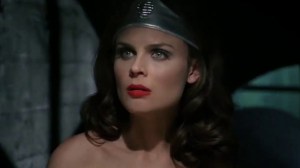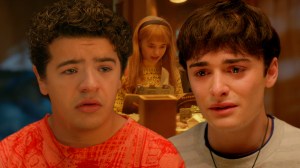The Halloween franchise is no stranger to endings, whether they be intentional or unexpected. Halloween II was designed by franchise co-creators John Carpenter and Debra Hill to kill Michael Myers once and for all, but over the course of the next 40 years, the series had undergone resurrections, retcons, and reboots, often only wrapping up a storyline when the financial response to a sequel dwindles. The current trilogy of David Gordon Green-directed films brought back not only original star Jamie Lee Curtis as Laurie Strode, but also Carpenter to serve as a composer and producer, bringing with it the most cultural attention in decades, with Halloween Ends billing itself as the culmination of Green’s plan for a sendoff to Laurie Strode. Despite having all the potential to do something new and organic with an intentional conclusion to the narrative, the film instead ends up honoring the franchise unexpectedly, as it’s messy, nonsensical, and leaves us wondering how much longer until we can get a new Halloween reboot.
Videos by ComicBook.com
Four years after the events of Halloween Kills, Michael Myers might have gone missing from the town of Haddonfield, Illinois, but his specter still looms large, with residents coping with the loss and grief caused by his night of mayhem. One tragedy, in particular, sees Corey (Rohan Campbell) becoming a new target for the town’s animosity, as he’s defined only by the worst event he’s ever been part of. Laurie and her granddaughter Allyson (Andi Matichak) attempt to process their own trauma, trying to put their pasts behind them, while a chance meeting with Corey results in the reveal that Michael Myers’ shadow still persists in the small Illinois town.
Unlike virtually every other installment in the Halloween franchise, since this trilogy’s inception, Green has described how it was conceived as a three-part experience. Whereas most other sequels could be boiled down to Halloween: The Next One, there seemed to be hints at underlying themes that Green and his various cowriters aimed to lean into with this trilogy, leading towards a destination. Even with Curtis back involved in the franchise, what is so frustrating about Halloween Ends is that it feels like a potpourri of half-thought ideas, none of which overlap with one another, and somehow retroactively make the successes of the previous two films feel like accidents.
As explored in 2018’s Halloween, Laurie’s battle with Michael back in 1978 was the defining moment of her life, with that event seeing her turn to substance abuse to cope with her PTSD and drive those closest to her away. Halloween Kills sidelined her as she tended to her injuries, with Halloween Ends finally giving us a look at what a Laurie Strode who has processed her trauma looks like. Halloween Ends presents Laurie as a kooky grandmother in one scene and a battle-worn survivor in the next. The appeal of the original Halloween was that there wasn’t anything special about Laurie, as she represented a teen who kept enough wits about her to evade Michael, yet left her and audiences confounded as to why a seemingly average girl became the target of a maniac. The challenge then is that there’s nothing this film can do with the character that harkens back to what we saw of Laurie in 1978, as she was defined by her lack of distinction. It feels just as strange to see Laurie embracing a life of domesticity as it was to see her preparing a weapons cache, yet that survivor Laurie could be justified by what we hadn’t seen in 40 years. In Halloween Ends, it’s almost as if we’re meeting Laurie for the very first time, given how unfamiliar she acts from previous films, so other than looking like Jamie Lee Curtis, this Laurie feels like an all-new character, thus denying the character the gravitas of the impending battle with Michael Myers.
Speaking of new characters, Campbell’s performance as Corey is complex and evokes empathy, but the inclusion of the character from a conceptual standpoint is baffling. While Michael Myers is the only constant in the franchise, these new films set themselves up as showcasing how Laurie is just as important to this storyline as the masked killer, only for Halloween Ends to give Corey far more narrative importance and screen time than Curtis’ icon. To dive too deeply into the more perplexing choices surrounding Corey would be heading into spoiler territory, but suffice it to say that this film feels less like a sendoff to Laurie and more as an origin story for Corey. It’s worth noting, however, that Matichak’s Allyson has consistently been delightful to watch in this franchise, not only holding her own against Curtis’ Laurie, but sometimes wishing for her character to become the focal point.
Green’s first Halloween explored the idea of overcoming trauma and the real-world impact of a madman stalking and killing your friends. Halloween Kills detailed the dangers of herd mentality and how, even with the best of intentions, all it took was a push in the right direction and the support of others for seemingly mild-mannered citizens to become bloodthirsty vigilantes. The message of Halloween Ends seems to want to be about grief and bullying and embracing your inner darkness, but it only ever scratches the surface of any of these ideas before it then has to dive back into the narrative momentum of concluding this trilogy. It’s not that the film has nothing to say, it’s that it never finds a good way to say it.
The biggest throughline would be about the dangers of embracing your own darkness, whatever shape (pun intended) that evil might take. While fans have debated about how Michael Myers has been able to survive the brutal violence he’s endured over the years, theorizing that there could be something supernatural about him, Ends teases that there’s something rotten about Haddonfield as a whole, seeping into its residents and with the town becoming its own microcosm of tragedy. It could be argued, then, that Myers represents pure id, which will cause you to become a dangerous lunatic, yet also gift you with the powers of super-healing and seeming immortality. The storyline somehow manages to both give us too much and too little all at once, offering as many questions as answers about Haddonfield and the true nature of its iconic killer.
What is even somehow more frustrating is that, while there was a steep decline in critical and audience reactions from Halloween to Halloween Kills, Halloween Ends somehow makes that previous film look both worse and better in retrospect. Given that it was a middle chapter, we knew that not all of that film’s questions would have answers. At some points in Kills, the story put emphasis on Michael’s mysterious desire to stand in his sister’s bedroom and look out over Haddonfield. There were hints that he wanted to see the town, or that he was actually looking at his own reflection in the window, but Halloween Ends never explores either of those ideas in an interesting or fulfilling way, retroactively making those thematic teases more irritating. However, the fact that townspeople chanting “evil dies tonight” effectively served as a satirical though all-too-real reminder of how groups of people can latch onto whatever snappy mantra suits their needs to justify their actions now feels like a masterclass in storytelling compared to the mess of Halloween Ends.
While Green’s first Halloween felt like a rehash of the original film and Halloween Kills felt like a revival of Halloween II, Halloween Ends feels like an amalgam of Jamie Lloyd-focused installments. We’re given a departure from Laurie Strode as a focal point, an exploration of the fallout of Michael Myers’ devastation in the town, hints at an overall explanation of what could drive someone to be a murderer, and even sequences of underground survival. Given that there are audiences who do enjoy these three lesser installments in the franchise, Halloween Ends is sure to find its champions, as some viewers are just happy to see that Michael Myers and Laurie Strode are back on the big screen. A finale sequence does make good on the idea that these two figures will have a final confrontation, yet even this battle feels undercooked and doesn’t elevate itself above any similar showdown we’ve already seen between Laurie and Michael in the series’ history.
In 1963, a young boy mysteriously murdered his sister. 15 years later, he escaped a mental institution and terrorized his hometown. 40 years later, he was let loose on the town once again, not only delivering a staggering number of deaths, but also surviving gunshots, stabbings, bludgeonings, and even a fiery inferno. Halloween Ends attempts to use a current-day story to explain how such a thing was possible, yet only ever feels like a rough draft. Halloween deserves better, Laurie deserves better, and even Michael Myers, a ruthless serial killer, somehow deserves better than what was offered in Halloween Ends.
Rating: 2 out of 5
Halloween Ends hits theaters and Peacock on October 14th.








